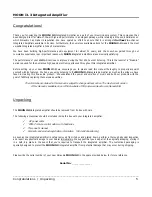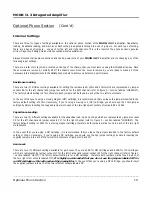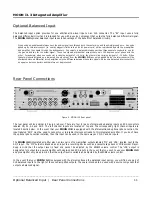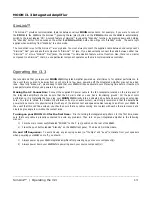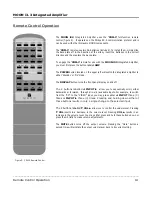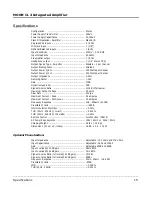
MOON i
3.3 Integrated Amplifier
SimLink™
The SimLink™ provides communication features between various MOON components. For example, if you were to connect
the CD
3.3 to the i
3.3 via the SimLink™, pressing the
X
(play) button on the CD
3.3 will cause the i
3.3 to automatically
switch to the input labeled ‘CD’. A second feature of SimLink™ involves the “Standby” function. By pressing down and holding
the “Standby” button for 2 seconds on the either the CD
3.3 or i
3.3, both units will go into “Standby” mode. The same logic
applies when switching from “Standby” to active mode.
The connection rules for the SimLink™ are very basic. You must always connect the supplied cable between one component’s
“SimLink™ Out” jack and another component’s “SimLink™ In” jack. If you inadvertently connect the cable between either two
“SimLink™ In” or two “SimLink™ Out” jacks, the SimLink™ communication feature will not function. Also, there is no master
component in a SimLink™ chain; no one particular component operates as the main communications controller.
Operating the i
3.3
We recommend that you leave your MOON i
3.3 Integrated Amplifier powered up at all times to for optimal performance. In
the event that you plan to be away from your home for a few days, powering off the Integrated Amplifier may not be a bad
idea. Once fully “broken-in”, please keep in mind that your i
3.3 will require several hours of playing time before it reaches its
peak performance after you’ve powered it up again.
Making the AC Connection:
Connect the supplied AC power cable to the IEC receptacle, located on the rear panel of
the integrated amplifier’s chassis. Ensure that the AC wall outlet you use has a functioning ground. For the best sonic
performance, it is preferable that you plug your MOON i
3.3 directly into a dedicated AC outlet and avoid using an extension
cord. In order to obtain the maximum performance from your audio system, we strongly recommend that the detachable
power cord not come into physical contact with any of the interconnect and speaker cables running to and from your i
3.3. In
the event that this can’t be avoided, you should ensure that any cables coming into contact with each other are crossed at a
ninety degree angle to minimize the contact area.
Turning on your MOON i
3.3 for the first time:
Prior to turning the integrated amplifier on for the first time, make
sure that every cable is properly connected to avoid any problems. Then turn on your integrated amplifier in the following
manner:
1)
Flick the main rocker switch labeled “POWER” to the ‘1’ (on) position on the rear of the i
3.3.
2)
Press the push button labeled “Standby” on the i
3.3s front panel. The blue LED will illuminate.
On and Off Sequence:
To avoid having any annoying noises (ie. “thumps” and “pops”) emanate from your speakers
when powering your i
3.3 on or off, you should:
1)
Always power up your i
3.3 integrated amplifier after powering up your source component(s).
2)
Always power down your i
3.3 before powering down your source component(s).
____________________________________________________________________________________
SimLink™ / Operating the i3.3
13





